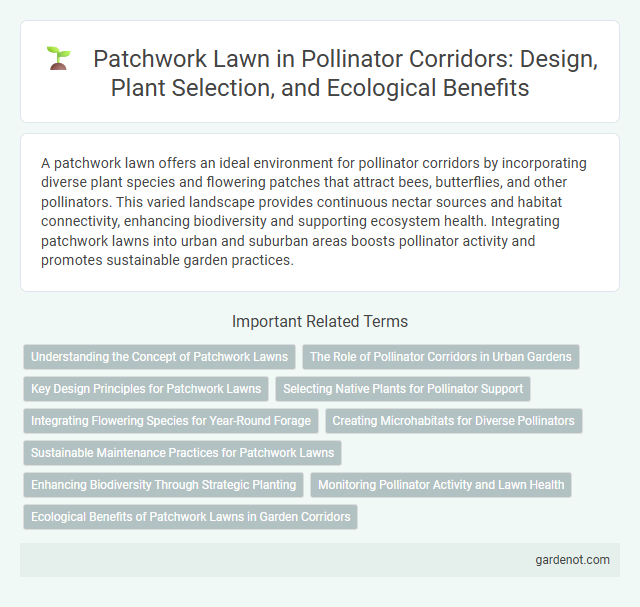A patchwork lawn offers an ideal environment for pollinator corridors by incorporating diverse plant species and flowering patches that attract bees, butterflies, and other pollinators. This varied landscape provides continuous nectar sources and habitat connectivity, enhancing biodiversity and supporting ecosystem health. Integrating patchwork lawns into urban and suburban areas boosts pollinator activity and promotes sustainable garden practices.
Understanding the Concept of Patchwork Lawns
Patchwork lawns consist of diverse plant species arranged in irregular, overlapping patterns that create a rich habitat for pollinators like bees and butterflies. This design promotes biodiversity by combining native wildflowers, grasses, and ground covers, which enhance nectar and pollen availability throughout the growing season. Patchwork lawns support ecological balance and improve pollinator population resilience within urban and suburban environments.
The Role of Pollinator Corridors in Urban Gardens
Pollinator corridors, including patchwork lawns, play a crucial role in supporting biodiversity within urban gardens by linking isolated habitats and providing continuous foraging opportunities for bees, butterflies, and other pollinators. These corridors enhance pollination efficiency, contributing to healthier plant growth and increased urban food production. Establishing diverse native plant species within these green networks maximizes ecological connectivity and resilience against habitat fragmentation.
Key Design Principles for Patchwork Lawns
Patchwork lawns optimize biodiversity by integrating diverse native grasses, flowering plants, and shrubs to create continuous pollinator habitats. Design principles emphasize plant variety, spatial arrangement for pollinator movement, and seasonal flowering to ensure consistent nectar and pollen sources. This approach enhances ecosystem resilience and supports pollinator species by mimicking natural landscapes within urban and suburban environments.
Selecting Native Plants for Pollinator Support
Selecting native plants such as milkweed, purple coneflower, and black-eyed Susan enhances pollinator corridors by providing essential nectar and pollen sources for bees, butterflies, and hummingbirds. Native plants are well-adapted to local soil and climate conditions, requiring less maintenance and supporting a diverse ecosystem. Incorporating a diverse mix of flowering species blooming at different times ensures continuous food supply throughout the growing season for pollinators.
Integrating Flowering Species for Year-Round Forage
Patchwork lawns integrate a diverse mix of flowering species such as clover, violets, and native grasses to provide continuous forage for pollinators throughout the year. This approach supports bees, butterflies, and other beneficial insects by ensuring a steady nectar and pollen supply across seasons. Incorporating a variety of bloom times enhances ecosystem resilience and promotes biodiversity within pollinator corridors.
Creating Microhabitats for Diverse Pollinators
Patchwork lawns enhance pollinator corridors by incorporating varied plant species and structures that create essential microhabitats for diverse pollinators such as bees, butterflies, and hoverflies. Integrating native wildflowers, clover patches, and mounded soil areas supports nesting, foraging, and shelter opportunities, promoting biodiversity and ecosystem resilience. These microhabitats increase pollen and nectar availability throughout the growing season, vital for sustaining pollinator populations.
Sustainable Maintenance Practices for Patchwork Lawns
Patchwork lawns enhance pollinator corridors by integrating diverse native plant species that support local biodiversity and improve soil health. Sustainable maintenance practices include minimal mowing schedules to preserve flowering periods and the use of organic fertilizers to reduce chemical runoff. Implementing targeted watering systems optimizes water use efficiency, promoting robust plant growth while conserving resources in patchwork lawn ecosystems.
Enhancing Biodiversity Through Strategic Planting
Strategic planting of patchwork lawns combines native wildflowers, grasses, and shrubs to create diverse habitats that support pollinators like bees, butterflies, and hummingbirds. This variety in plant species ensures continuous blooms throughout seasons, providing essential nectar and pollen sources that enhance local biodiversity. Implementing patchwork lawns in pollinator corridors strengthens ecological networks and promotes resilience against environmental stressors.
Monitoring Pollinator Activity and Lawn Health
Patchwork lawns enhance pollinator corridors by providing diverse habitats that support varied pollinator species. Monitoring pollinator activity involves tracking visitation rates and species diversity to assess ecosystem health and pollination effectiveness. Regular lawn health assessments focus on soil quality, plant vigor, and floral abundance to ensure optimal conditions for sustaining pollinator populations.
Ecological Benefits of Patchwork Lawns in Garden Corridors
Patchwork lawns enhance biodiversity by providing diverse habitats for pollinators such as bees, butterflies, and hoverflies within garden corridors. Their varied plant species support a continuous supply of nectar and pollen, crucial for sustaining pollinator populations throughout different seasons. This ecological design improves soil health, reduces the need for chemical inputs, and strengthens local ecosystems by connecting fragmented pollinator habitats.
Patchwork lawn Infographic

 gardenot.com
gardenot.com